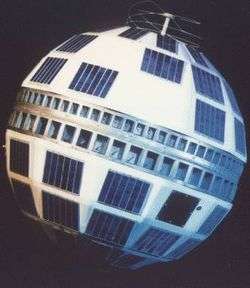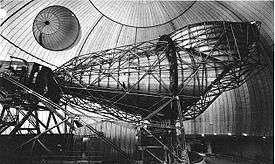Telstar 1
 The original Telstar had a roughly spherical shape. | |
| Operator | AT&T / NASA |
|---|---|
| COSPAR ID | 1962-029A[1] |
| SATCAT no. | 340 |
| Spacecraft properties | |
| Manufacturer | Bell Labs |
| Launch mass | 171 kilograms (377 lb) |
| Start of mission | |
| Launch date | 08:35:00, July 10, 1962 |
| Rocket | Thor-Delta |
| Launch site | Cape Canaveral LC-17B |
| End of mission | |
| Deactivated | February 21, 1963 |
| Orbital parameters | |
| Reference system | Geocentric |
| Regime | Medium Earth |
| Perigee | 952 kilometres (592 mi) |
| Apogee | 5,933 kilometres (3,687 mi) |
| Inclination | 44.8° |
| Period | 2 hours and 37 minutes |
| Epoch | 1962-07-10 08:35:00 UTC |
|
|
Telstar 1 was a communications satellite launched by NASA on July 10, 1962, it was the satellite that allowed the first live broadcast of television images between the United States and Europe. It remained active for only 7 months, a much shorter service life than today's artificial satellites. Although it no longer works, it is still in the orbit of the Earth.
History


The idea of transmitting various information through satellites was ancient. Already in October 1945, the mathematician and visionary Arthur C. Clarke published an article talking about it in the specialized magazine Wireless World. His idea was to take advantage of the immensity of space to transmit information, using a satellite system for this purpose. During the Cold War years, the shock caused by the successful launch of the first man-made artificial satellite, Sputnik 1, by the Soviets increased the United States' interest in the development of aerospace research. Soon after the launch of what would become known as Earth's first artificial satellite, Sputnik in 1957, the Americans began their attempts to launch communications satellites. These circled the planet in elliptical or circular orbits and aimed to improve telecommunications services such as telephones, radio and television.[3]
The first artificial satellite that the United States successfully put into space was named SCORE and was launched in December 1958. Through it, then-President Dwight D. Eisenhower sent a Christmas message to the entire world. But SCORE stayed in orbit for only a few months. Its enormous surface and the orbit very close to the planet Earth made it reenter after only 500 laps around the planet.
Launch
Telstar 1 was released on July 10, 1962 from the Cape Canaveral Air Force Station, Florida, with a Delta rocket. In a rounded form, the satellite had a diameter of 88 centimeters and weighed 77 pounds (35 kg).
Operations
A 53-meter terrestrial antenna manufactured by AT&T Corporation, located in Andover, Maine. She is responsible for the transmissions between the U.S. and Europe. Built in 1961, and used by Telstar 1, it was later used by Relay 1. Telstar 1 operated normally from launch until November 1962 when the radiation from the Starfish Prime operation affected the command channel, which began to behave erratically. The satellite was continuously switched on to work around this problem. On November 23, 1962, the command channel stopped responding. On December 20, the satellite was successfully reactivated, and intermittent data were obtained until February 21, 1963, when the transmitter failed. The energy used by it was produced by 3,600 solar cells. Thirteen days after the launch, the first live broadcast of a television show between the United States and Europe took place.[4]
Germany was one of the countries that participated in the broadcasts, with live footage showing workers at a blast furnace in the industrial area of Duisburg, located in the west of the country. From a quality point of view, the images were extremely bad by today's standards.
The live images of New York City and the Golden Gate bridge came trembling to the television set, but at least they gave the sensational impression of watching an event on the other side of the world. The quality of the images transmitted between the two continents, in 1962, was very distant from the present one. In addition, the time of these transmissions were not continuous, they were restricted in 30 minutes, due to the low orbit of the satellite. It was necessary for the receiving and transmitting antennas to allow the earth stations to follow their orbital trajectory. Its transmitter with the tiny power of 2¼ watts had such weak signals that the stations that accompanied it received them and magnified 10 billion times through 30-m-diameter parabolic antennas.
From this prototype, thousands of satellites have been launched in Earth orbit since the 1960s, mostly for military, scientific and telecommunications purposes.
References
- ↑ NASA, Goddard Space Flight Center. "Telstar 1". National Space Science Data Center Master Catalog. Retrieved May 31, 2018.
- ↑ "Felker Talking Telstar". WNYC. Retrieved 2016-10-31.
- ↑ DW. "1962: Nasa lança ao espaço o primeiro satélite de comunicações" (in Portuguese). Retrieved May 31, 2018.
- ↑ Dalgleish, 1989. "An Introduction to Satellite Communications". books.google.co.uk. Retrieved May 31, 2018.